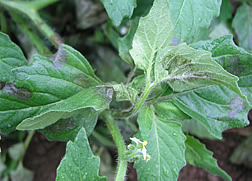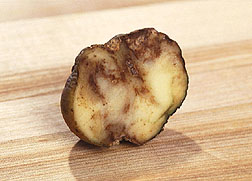This page has been archived and is being provided for reference purposes only. The page is no longer being updated, and therefore, links on the page may be invalid.
Weed Implicated in Potato Blight Persistence
By Erin PeabodyDecember 12, 2006
Late blight, the devastating tuber disease that triggered the Irish potato famine of the mid-1800s, has a new partner in crime.
Scientists with the Agricultural Research Service (ARS) in Orono, Maine, discovered that Phytophthora infestans—the microorganism behind the spud-spoiling disease—is seeking refuge in potato fields, holed up in an alternate host plant: hairy nightshade.
Best known for causing widespread hunger, illness and death in 1840s Ireland, P. infestans continues to pose a formidable threat to global potato and tomato production. According to the International Potato Center in Lima, Peru, the disease costs the world's growers more than $3 billion each year in fungicides and other control measures.
Modesto Olanya, a plant pathologist at the ARS New England Plant, Soil and Water Research Laboratory in Orono, learned of the possibility of an alternate host in 2004 from colleagues at the University of Maine Cooperative Extension in Presque Isle.
As extension agents in the northern part of the state discovered, hairy nightshade plants were showing up speckled with suspicious dark and oily spots. Olanya analyzed the microorganisms on the plants and verified, for the first time, that hairy nightshade is an alternate host of P. infestans in Maine.
To make matters worse, hairy nightshade is hardly a wallflower, in terms of its presence in commercial potato fields in Maine. In a limited survey, Olanya and University of Maine collaborators found that 55 percent of fields assessed in the state contained the plant.
According to Olanya, the finding that hairy nightshade is an active host of P. infestans is problematic in two ways. First, the plant is a secondary source of the destructive disease. And, it's a weed.
As a result of this ARS research, growers are now learning the importance of controlling hairy nightshade as part of their overall late blight management program.
ARS is the chief scientific research agency of the U.S. Department of Agriculture.


